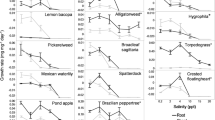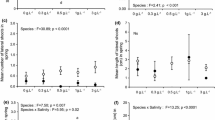Abstract
A submerged aquatic plant Elodea canadensis is highly invasive in Eurasia and has a very high ability to spread within the water ecosystems. There is currently no data on the tolerance range of salinity in which E. canadensis can survive. This makes it difficult to assess the possible distribution range of this important invasive species under natural conditions and to predict the possibility of its introduction into new water bodies. The aim of the study is to evaluate the tolerance salinity range for E. canadensis by the parameters of water-salt homeostasis. Here we show that the tolerance range of salinity for E. canadensis is 0.0001–6 g/L NaCl. Within the tolerance salinity range E. canadensis maintains the parameters of water-salt homeostasis within physiological limits, as well as carries out photosynthesis and growth. The upper limit of the salinity tolerance range is determined by the pattern of regulation of the potassium concentration in the body. At salinities above 6 g/L NaCl, a decrease in the concentration of potassium in the body below physiological values is observed, along with a sharp violation of the ratio of Na/K concentration, lack of growth and photosynthesis, and loss of green color of leaves. The optimal salinity range for E. canadensis is 0.009 (fresh water)—1.2 g/L NaCl, at which an increase in dry mass and the largest growth were observed. The critical salinity zone for elodea is 2.4–6 g/L NaCl, at which a decrease in the growth rate of the main and lateral shoots is observed. E. canadensis can inhabit and develop only in those water bodies where the salinity of the water is within the tolerance range. Based on the obtained results and the availability of data on salinity in various water bodies, it is possible to estimate the boundaries of areal of E. canadensis in natural conditions, and to make a prediction about the possibilities of its introduction into brackish lakes, river estuaries, coastal brackish waters of the seas, which is especially important in the current conditions of the ongoing salinization of water bodies due to various factors.

Similar content being viewed by others
Data availability
The data that support the findings of this study are available from the corresponding author upon reasonable request.
References
Baltic Sea Alien Species Database (2007) Olenin S, Daunys D, Leppäkoski E, Zaiko A (eds). Accessed: November 15 2007, from http://www.corpi.ku.lt/nemo/
Barrat-Segretain MH (2005) Competition between invasive and indigenous species: impact of spatial pattern and developmental stage. Plant Ecol 180:153–160. https://doi.org/10.1007/s11258-004-7374-7
Barrat-Segretain MH, Elger A, Sagnes P, Puijalon S (2002) Comparison of three life-history traits of invasive Elodea canadensis Michx. and Elodea nuttallii (Planch.) H. St John Aquat Bot 74:299–313. https://doi.org/10.1016/S0304-3770(02)00106-7
Bazarova BB, Pronin NM (2010) Elodea canadensis Michaux in the watershed of the Arctic and the Pacific Oceans. Russ J Biol Invasions 1:243–250. https://doi.org/10.1134/S2075111710040016
Bisson MA, Kirst GO (1983) Osmotic adaptations of charophyte algae in the Coorong, South Australia and other Australian lakes. Hydrobiologia 105:45–51. https://doi.org/10.1007/BF00025175
Bowmer KH, Jacobs SWL, Sainty GR (1995) Identification, biology and management of Elodea canadensis, Hydrocharitaceae. J Aquat Plant Manage 33:13–19
Bowmer KH, Mitchell DS, Short DL (1984) Biology of Elodea canadensis Mich. and its management in Australian irrigation systems. Aquat Bot 18:231–238. https://doi.org/10.1016/0304-3770(84)90064-0
Brock MA, Nielsen DL, Crossle K (2005) Changes in biotic communities developing from freshwater wetland sediments under experimental salinity and water regimes. Freshw Biol 50:1376–1390. https://doi.org/10.1111/j.1365-2427.2005.01408.x
Bubikova K, Svitkova I, Svitok M, Hrivnak R (2021) Invasive elodeas in Slovakia (Central Europe): distribution, ecology and effect on native macrophyte assemblages. Aquat Invasions 16:617–636. https://doi.org/10.3391/ai.2021.16.4.03
Canedo-Arguelles M, Kefford BJ, Piscart C, Prat N, Schafer RB, Schulz C-J (2013) Salinisation of rivers: an urgent ecological issue. Environ Pollut 173:157–167. https://doi.org/10.1016/j.envpol.2012.10.011
Canedo-Arguelles M, Kefford B, Schafer R (2019) Salt in freshwaters: causes, effects and prospects—introduction to the theme issue. Phil Trans R Soc B 374:20180002. https://doi.org/10.1098/rstb.2018.0002
Clayton JS (1996) Aquatic weeds and their control in New Zealand Lakes. Lake Reserv Manag 12:477–486. https://doi.org/10.1080/07438149609354288
Cook CDK (1985) Range extensions of aquatic vascular plant species. Aquat Plant Man 23:1–6
Cook CDK, Urmig-König KA (1985) Revision of the genus Elodea (Hydrocharitaceae). Aquat Bot 21:111–156. https://doi.org/10.1016/0304-3770(85)90084-1
Davis A, Clegg CJ (2017) Biology for the IB diploma study and revision guide. Hachette UK, London
Dugan HA, Bartlett SL, Burke SM et al (2017) Salting our freshwater lakes. Proc Natl Acad Sci USA 114:4453–4458. https://doi.org/10.1073/pnas.1620211114
Golovanov YM, Abramova LM, Muldashev AA (2016) Naturalization of invasive Elodea canadensis Michx. in waters of the Republic of Bashkortostan. Russ J Biol Invasions 7:209–219. https://doi.org/10.1134/S2075111716030048
French GT, Moore KA (2003) Interactive effects of light and salinity stress on the growth, reproduction, and photosynthetic capabilities of Vallisneria americana (wild celery). Estuaries 26:1255–1268. https://doi.org/10.1007/BF02803628
Gromov VV (2010) Higher-plant aquatic and coastal vegetation of the Northern Caspian: Volga Foredelta, Kalmyk and Kazakh Coasts. J Sib Fed Univ Biol 3:250–266 (in Russian)
Hart BT, Bailey P, Edwards R, Hortle K, James K, McMahon A, Meredith C, Swadling K (1991) A review of the salt sensitivity of the australian fresh-water biota. Hydrobiologia 210:105–144. https://doi.org/10.1007/BF00014327
Hauenstein E, Ramırez C (1986) The influence of salinity on the distribution of Egeria densa in the Valdivia river basin, Chile. Arch Hydrobiol 107:511–519
Hellebust JD (1976) Osmoregulation. Ann Rev Plant Physiol 27:485–505. https://doi.org/10.1146/annurev.pp.27.060176.002413
Hussner A (2012) Alien aquatic plant species in European countries. Weed Res 52:297–306. https://doi.org/10.1111/j.1365-3180.2012.00926.x
James KR, Hart BT (1993) Effect of salinity on 4 freshwater macrophytes. Aust J Mar Freshwater Res 44:769–777. https://doi.org/10.1071/MF9930769
James KR, Hart BT, Bailey PCE, Blinn DW (2009) Impact of secondary salinisation on freshwater ecosystems: effect of experimentally increased salinity on an intermittent floodplain wetland. Mar Freshwater Res 60:246–258. https://doi.org/10.1071/MF08099
Jeppesen E, Brucet S, Naselli-Flores L et al (2015) Ecological impacts of global warming and water abstraction on lakes and reservoirs due to changes in water level and related changes in salinity. Hydrobiologia 750:201–227. https://doi.org/10.1007/s10750-014-2169-x
Kipriyanova LM, Efremov AN, Kotovshchikov AV, Yanygina LV (2019) The Elodea canadensis Michx. records in Novosibirsk Region (Russia). Russ J Biol Invasions 10:227–235. https://doi.org/10.1134/S2075111719030068
Kirst GO (1977) Ion composition of unicellular marine and fresh-water algae, with special reference to Platymonas subcordijbrmis cultivated in media with different osmotic strengths. Oecologia (berl) 28:177–189. https://doi.org/10.1007/BF00345253
Kirs GO, Bisson MA, (1979) Regulation of turgor pressure in marine algae: ions and low-molecular weight organic compounds. Aust J Plant Physiol 6:539–556. https://doi.org/10.1071/PP9790539
Kolada A, Kutyla S (2016) Elodea canadensis (Michx.) in Polish lakes: a non-aggressive addition to native flora. Biol Invasions 18:3251–3264. https://doi.org/10.1007/s10530-016-1212-4
Krasnova AN, Kuzmichev AI, Dzhalalova MI (2013) Features littoral ecotone of the Middle Caspian sea (within Terek-Kuma lowland). Aridnyye Ekosistemy 19:51–57 (in Russian)
Kravtsova LS, Izhboldina LA, Mekhanikova IV, Pomazkina GV, Belykh OI (2010) Naturalization of Elodea canadensis Mich. in Lake Baikal. Russ J Biol Invasions 1:162–171. https://doi.org/10.1134/S2075111710030045
Lokhande VH, Nikam TD, Penna S (2010) Biochemical, physiological and growth changes in response to salinity in callus cultures of Sesuvium portulacastrum L. Plant Cell Tiss Organ Cult 102:17–25. https://doi.org/10.1007/s11240-010-9699-3
Maltseva SY, Bobrov AA (2017) Alien species of vascular plants in the Rybinsk Reservoir (Upper Volga, Russia). Russ J Biol Invasions 8:321–326. https://doi.org/10.1134/S2075111717040063
Martemyanov VI (2014) Threshold concentrations of cations in the external environment required for maintenance of the ionic balance between the organism of the invader Elodea canadensis Michaux and fresh water. Russ J Biol Invasions 5:265–274. https://doi.org/10.1134/s2075111714040043
Martemyanov VI, Borisovskaya EV (2012) Indices of salt and water metabolism in tubenose goby Proterorhinus marmoratus Pallas, introduced into Rybinsk reservoir, and in indigenous carp Cyprinus carpio L. depending on environmental salinity. Russ J Biol Invasions 3:110–117. https://doi.org/10.1134/S2075111712020075
Martemyanov VI, Mavrin AS (2012) Threshold environmental concentrations of cations determining the boundaries of survival of the filamentous alga Spirogyra sp. in freshwater reservoirs. Contemp Probl Ecol 5:250–254. https://doi.org/10.1134/S1995425512030122
Martemyanov VI, Poddubnaya NY (2019) Volume regulation of muscle cells in the carp Cyprinus carpio in response to hypernatremia. Bratisl Med J 120:52–57. https://doi.org/10.4149/BLL_2019_008
Martemyanov VI, Poddubnaya NY (2020) Regulation ranges and patterns of adaptation to hyponatremia by cells of various organs and tissues of vertebrate animals. Bratisl Med J 121:218–224. https://doi.org/10.4149/BLL_2020_033
Raspopov IM, Adamec L, Husak S (2002) Influence of aquatic macrophytes on the littoral zone habitats of the Lake Ladoga, NW Russia. Preslia Praha 74:315–321
Rout NP, Shaw BP (2001) Salt tolerance in aquatic macrophytes: possible involvement of the antioxidative enzymes. Plant Sci 160:415–423. https://doi.org/10.1016/S0168-9452(00)00406-4
Shcherbakov AV, Ershkova EV, Khapugin AA, Lyubeznova NV (2022) Alien aquatic plant species in European Russia. Bot Zhurn 107:70–80
Shelford VE (1931) Some Concepts of Bioecology. Ecology 12:455–467. https://doi.org/10.2307/1928991
Spitcer KW, Catling PM (1988) The biology of Canadian weeds. 88. Elodea canadensis Michx. Can J Plant Sci 68:1035–1051. https://doi.org/10.4141/cjps88-125
Strizh IG, Popova LG, Balnokin YuV (2004) Physiological aspects of adaptation of the marine microalga Tetraselmis (Platymonas) viridis to various medium salinity. Russ J Plant Physiol 51:176–182. https://doi.org/10.1023/B:RUPP.0000019210.59579.6b
Sviridenko BF, Sviridenko TV, Efremov AN, Turner OE, Evzhenko KS, Tokar’ OE (2013) Elodea Canadian Elodea canadensis (Hydrocharitaceae) in the West Siberian Plain. Vestnik Tomskogo Universiteta: Biologiya 3:46–55 (in Russian)
Thouvenot L, Deleu C, Berardocco S, Haury J, Thiebaut G (2015) Characterization of the salt stress vulnerability of three invasive freshwater plant species using a metabolic profiling approach. J Plant Physiol 175:113–121. https://doi.org/10.1016/j.jplph.2014.11.007
Thouvenot L, Thiebaut G (2018) Regeneration and colonization abilities of the invasive species Elodea canadensis and Elodea nuttallii under a salt gradient: implications for freshwater invasibility. Hydrobiologia 817:193–203. https://doi.org/10.1007/s10750-018-3576-1
Tripathi SB, Gurumurthi K, Panigrahi AK, Shaw BP (2007) Salinity induced changes in proline and betaine contents and synthesis in two aquatic macrophytes differing in salt tolerance. Biol Plant 51:110–115. https://doi.org/10.1007/s10535-007-0022-z
Twilley RR, Barko JW (1990) The growth of submersed macrophytes under experimental salinity and light conditions. Estuaries 13:311–321. https://doi.org/10.2307/1351922
Vinogradova Y, Pergl J, Essl F et al (2018) Invasive alien plants of Russia: insights from regional inventories. Biol Invasions 20:1931–1943. https://doi.org/10.1007/s10530-018-1686-3
Wells RD, de Winton MD, Clayton JS (1997) Successive macrophyte invasions within the submerged flora of Lake Tarawera, central North Island, New Zealand. N Z J Mar Freshwater Res 31:449–459. https://doi.org/10.1080/00288330.1997.9516778
Acknowledgements
This research was performed in the framework of the state assignment: theme No. 121051100099-5 and was funded by the Tyumen Oblast Government, as a part of the West-Siberian Interregional Science and Education Center’s project no. 89-DON (2). We declare that we have no conflict of interest and no financial interest in the publication of this manuscript.
Author information
Authors and Affiliations
Corresponding author
Ethics declarations
Conflict of interest
The authors declare that they have no conflict of interest.
Ethical approval
The materials presented in the paper comply with ethical standards.
Additional information
Publisher's Note
Springer Nature remains neutral with regard to jurisdictional claims in published maps and institutional affiliations.
Rights and permissions
Springer Nature or its licensor holds exclusive rights to this article under a publishing agreement with the author(s) or other rightsholder(s); author self-archiving of the accepted manuscript version of this article is solely governed by the terms of such publishing agreement and applicable law.
About this article
Cite this article
Martemyanov, V.I., Tikhonenkov, D.V. Assessment of the tolerance range of salinity for invasive waterweed Elodea canadensis Michaux by parameters of water-salt homeostasis. Biol Invasions 24, 3845–3853 (2022). https://doi.org/10.1007/s10530-022-02885-5
Received:
Accepted:
Published:
Issue Date:
DOI: https://doi.org/10.1007/s10530-022-02885-5




